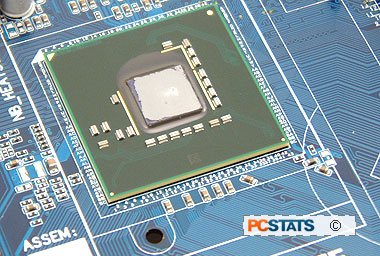The Intel P31 Express chipset was created for the entry level PC market, but don't let that fool you, the P31 Express is pretty powerful. Officially the chipset supports Celeron D, Pentium 4/D/XE and Core 2 Duo/Quad processors running on an 800 or 1066 MHz FSB. As mentioned earlier, Gigabyte has qualified the GA-P31-DS3L to run at 1333 MHz FSB, but that does not mean every Intel P31 Express motherboard will be able to do that. In so far as the GA-P31-DS3L is concerned, it will support Intel's upcoming 45nm Penryn processor. Intel ship the P31 Express with the Intel ICH7 series Southbridge.

Adding 45nm processor support to the Intel P31 Express means that consumers will have a low cost entry level platform to use should they need something on the inexpensive side. Of course with the platform only officially supporting FSB's up to 1066 MHz, you may have some limited options for future CPUs.
The P31 Express also only supports DDR2 memory up to a speed of 800 MHz, and a capacity of 4GB. Non-ECC unbuffered DDR2 memory is recommended.
One interesting feature that's built into the Intel P31 Express chipset is Intel's Flex Memory technology. While it's available in Intel's other P35 series chipsets, we haven't focused on it much because it's more of an entry level tool. To enable dual channel memory support with this platform, Intel claims that you can use memory of difference sizes.
We tried this and while the Gigabyte GA-P31-DS3L
motherboard would register dual channel memory support at
the POST screen, the system would BSOD while loading Windows. Looks like
Intel/Gigabyte has a bit of work to smooth out the rough spots. Still
this is an excellent feature for entry level systems if it actually works. PCSTATS didn't
have much luck, but we agree the concept of Flex Memory technology is a positive
development.
Here's a quick look at how the new P31 stacks up to the other Intel chipsets.
Apart from the speed increases and new memory standard, there are just a few
extra ports here and there.
|
Intel X38, P35, 975, 965 Series Chipset
Feature Breakdown |
|
Intel X38
Express Express |
Intel 975X Express |
Intel P35 Express Express
|
Intel P31 Express
Express |
Intel P965 Express
|
Intel G965 Express
|
| CPU |
LGA775 Core 2 Duo |
LGA775 Core 2 Duo |
LGA775 Core 2 Duo |
LGA775 Core 2 Duo |
LGA775 Core 2 Duo |
LGA775 Core 2 Duo |
| Front Side Bus (FSB) |
1600/1333/1066/800 MHz |
1066/800 MHz |
1333/1066/800 MHz |
(1333* unofficial) /1066/800 MHz |
1066/800/533 MHz |
1066/800/533 MHz |
| Intel Flex Memory Technology |
Yes |
Yes |
Yes |
Yes |
Yes |
Yes |
| Dual Channel Memory Support |
DDR2 1066/800/667
DDR3
1333(unofficial)/1066/800 |
DDR2 800/667/533 |
DDR2 1066/800/667
DDR3
1333(unofficial)/1066/800 |
DDR2 800/667 |
DDR2 800/667/533 |
DDR2 667 |
| Maximum Memory Capacity |
8GB |
8GB |
8GB |
4GB |
8GB |
8GB |
| Integrated Graphics |
- |
- |
- |
- |
- |
GMA 3000 |
| PCI Express x16 |
2 |
2 |
1 |
2 |
1 |
1 |
| PCI Express x1 |
4 |
4 |
6 |
4 |
4 |
4 |
| Intel Matrix Storage Technology |
Yes |
Yes |
Yes |
Yes |
Yes |
Yes |
| SATA/IDE HDD |
6/0 |
4/1 |
6/0 |
4/1 |
6/0 |
6/0 |
| SATA Speed |
3Gb/s |
3Gb/s |
3Gb/s |
3Gb/s |
3Gb/s |
3Gb/s |
| RAID |
0, 1, 5, 10 (with ICH9R) |
0, 1, 5, 10 (with ICH7R) |
0, 1, 5, 10 (with ICH9R) |
0, 1, 5, 10 (with ICH7R) |
0, 1, 5, 10 (with ICH8R) |
0, 1, 5, 10 (with ICH8R) |
| Hard Drive NCQ |
Yes |
- |
Yes |
- |
Yes |
Yes |
| USB 2.0 Ports |
12 |
8 |
12 |
8 |
8 |
10 |
| PCI Masters |
6 |
6 |
6 |
6 |
6 |
6 |
| Audio |
High Definition Audio (Azalia) |
High Definition Audio (Azalia) |
High Definition Audio (Azalia) |
High Definition Audio (Azalia) |
High Definition Audio (Azalia) |
High Definition Audio (Azalia) |
 |
 |
 |

|

|
 |
 | | |
The Intel P31 Express chipset is PCI Express 1.1 compatible and supports one PCI Express x16 slot for videocards. It has an additional six PCI Express lanes from the Intel ICH7 Southbridge. The main difference between the Intel P35 series chipsets and the P31 Express is that is paired with Intel's ICH7 Southbridge instead of the ICH9.
The ICH7 Southbridge incorporates four Serial ATA
II channels, a 7.1 channel Intel Azalia high definition audio codec, eight USB
2.0 slots, six PCI Express x1 lanes and an integrated Intel Gigabit MAC which
runs through the PCI Express bus. It's
important to note that the ICH7-series of Southbridges support a single Parallel
IDE channel. The latest Intel ICH9 chipset does away with parallel IDE support
completely.
Overclocking is next. Any bets on how this entry level
Gigabyte motherboard will handle itself when PCSTATS puts speed into
overdrive?
